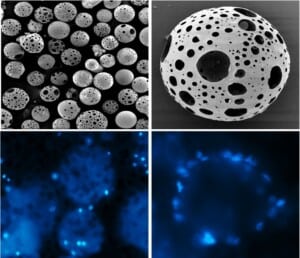Research Impact Report - Project 522
Influencing Stem Cells down an Osteogenic Lineage via Release of Therapeutic Ions from Resorbable Porous Calcium Phosphate Microspheres
Principal Investigator Dr Ifty Ahmed
Stream PhD
Duration 36 Months
Cost £72,566
Lay summary
1 in 2 women and 1 in 5 men over the age of 50 will suffer bone fractures as a result of osteoporosis, a health condition that slowly weakens bones making them much more fragile and prone to fractures. In the UK alone over 3 million people are estimated to have osteoporosis, with over 500,000 fragility fractures occurring each year, costing the NHS around £4.4 Bn each year, up from £2.3 Bn 3 years ago. The recent pandemic and associated lack of activity will have only exacerbated this further.
This project aimed to develop a fracture prevention treatment, targeting the elderly population, by identifying and treating patients at high-risk of bone fractures, before they happen. We have developed a novel porous calcium phosphate microsphere technology which can be used with and without biologics (for example, stem cells or other biological factors) and be delivered via minimally invasive injection directly into areas of bone weakened due to osteoporosis, to regenerate the bone in that area.
The microspheres have been developed to slowly degrade over time in the body releasing calcium and phosphate ions and can also deliver biologics to promote new bone tissue regeneration within osteoporosis compromised areas. This would represent significant advantages over current treatments (for e.g. bisphosphonate drugs) that do not regenerate bone and patients on these drugs still endure fragility fractures. This treatment option would also avoid side effects by negating drug compliance concerns.
The proposed prophylactic technology could be provided as a day-case ‘Fracture Prevention’ treatment which would advance current treatment, offering patient and societal benefits whilst significantly reducing healthcare costs. Osteoporosis related fragility fractures constitute a ‘silent epidemic’ since there are no associated warning signs prior to fracture. Furthermore, occurrence of a first fracture creates a significant risk factor for subsequent fractures, which can be disabling. Our microsphere technology could potentially prevent spinal and hip fractures from occurring thus sparing the elderly from surgical intervention and its associated reduction in quality of life.

Impact statement
We propose a way to address the above issue via a stem cell therapy treatment delivered through a minimally invasive injection as a day case procedure.
Its worth noting that other cell types or cell derivatives can also be considered
Autologous or allogeneic stem cells (or cell derivatives) could be delivered to key areas which present with the highest morbidity (e.g. hip and spine) through the use of porous phosphate-based glass microspheres.
In addition to transporting cells, the glass compositions used would be designed to degrade slowly over time to be completely resorbed by the body whilst also releasing ions to support cell proliferation and regeneration.
Fundamental problem trying to address
Osteoporosis is a debilitating disease which causes a continuous reduction in bone mineral density, weakening the microarchitecture of the bone leading to an increased risk of a fracture. This disease is becoming increasingly prevalent in the aging population effecting more than 3,000,000 people in the UK. Unfortunately, these numbers are likely to have been grossly underestimated since there are no symptoms of this disease prior to a fracture with 1 in 2 women and 1 in 5 men over the age of 50 affected. This disease is known to cause more than 500,000 fractures every year that require hospital treatment and, in most cases, require surgical intervention and is costing the NHS over £4.4 billion per year.
Aims and objectives
The aim of this research was to develop resorbable porous phosphate glass microspheres to deliver stem cells (or cell derivatives ) via a minimally invasive procedure to prophylactically regenerate bone tissue in patients diagnosed to be at high-risk of fracture due to osteoporosis.
Objectives:
- Develop a series of phosphate-based glass formulations with high pyrophosphate and orthophosphate content to mimic bisphosphonate drugs and aid bone mineralisation.
- Manufacture and characterise both bulk and porous microspheres from the glass formulations developed.
- Perform structural and thermal analysis, degradation and ion release studies on the novel formulations developed.
- Investigate stem cell behavior, response and interactions with the phosphate glass microsphere formulations developed exploring promotion of bone formation and mineralization pathways and mechanisms.
Intellectual property
There could be scope for potential IP protection based on possible combinations of new microsphere formulations with varying biologics.
The novel glass formulations developed herein have been published as they would have been difficult to protect given the information provided in the original patent (patent no: WO2016027110A1).
Team members & other funders
Other Funders and collaborators:
The funding for this project has also been kindly supported by Lucideon (https://www.lucideon.com/ – based in Stoke-on-Trent).
Publications
Journal Publication:
Nigel De Melo, Lauren Murrell, Md Towhidul Islam, Jeremy J. Titman, Laura Macri-Pellizzeri, Ifty Ahmed, and Virginie Sottile. Tailoring Pyro- and Orthophosphate Species to Enhance Stem Cell Adhesion to Phosphate Glasses. Int. J. Mol. Sci. 2021, 22(2), 837; https://doi.org/10.3390/ijms22020837
Conference Presentation:
Authors: Lauren A. J. Murrell, Nigel de Melo, Virginie Sottile and Ifty Ahmed.
Abstract Topic: Current and future treatment modalities for osteoporosis.
Abstract Title: Osteoporotic Fracture Prevention via Minimally Invasive Injection Procedure.
BONE2019 — The European Congress in Osteoporosis and Bone Diseases. June 27th & 28th
Links
Paper published with some of the preliminary results of this project.
https://www.mdpi.com/1422-0067/22/2/837
Conference proceeding info: Details of conference presentation are:
Conference Presentation:
Authors: Lauren A. J. Murrell, Nigel de Melo, Virginie Sottile and Ifty Ahmed.
Abstract Topic: Current and future treatment modalities for osteoporosis.
Abstract Title: Osteoporotic Fracture Prevention via Minimally Invasive Injection Procedure.
BONE2019 — The European Congress in Osteoporosis and Bone Diseases. June 27th & 28th
Newspaper articles related to the technology development from previous funding awards:
https://www.thetimes.co.uk/article/liquid-bone-jab-may-prevent-breaks-in-elderly-nntb3hgc7mg


Tell us your thoughts